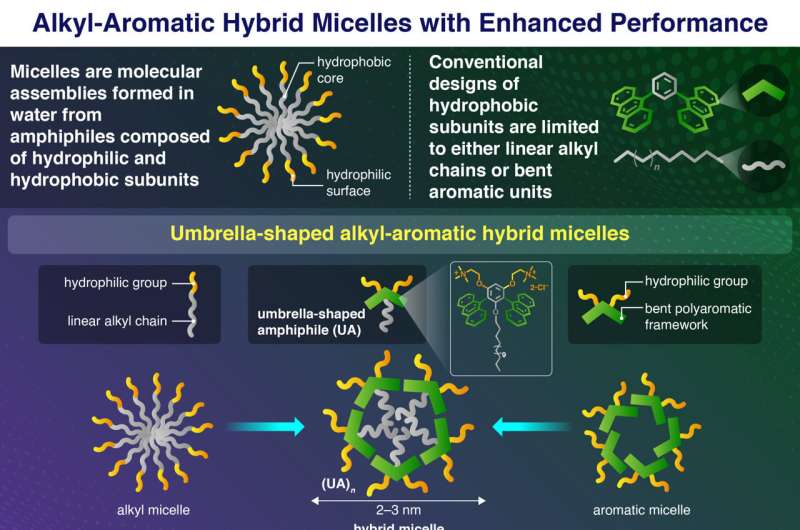This article has been reviewed according to Science X's editorial process and policies. Editors have highlighted the following attributes while ensuring the content's credibility:
fact-checked
peer-reviewed publication
trusted source
proofread
Study shows alkyl-aromatic hybrid micelles can form from emergent umbrella-shaped molecules

Micelles assemble in water from amphiphilic molecules, composed of hydrophilic and hydrophobic frameworks. They can be found all around us, for example in soaps, detergents, and shampoos. Their main application is the water-solubilization of insoluble molecules through encapsulation into hydrophobic cavities.
These cavities are conventionally composed of linear alkyl-chains, providing good interactions with alkyl-based guests, yet poor interactions with aromatic compounds. In addition, the rather weak intermolecular alkyl-alkyl type interactions result in an overall poor stability against heat and dilution.
In 2013, Kei Kondo and Michito Yoshizawa from Tokyo Tech's Laboratory for Chemistry and Life Science in Japan reported a new class of micelles, so-called aromatic micelles, formed from bent anthracene-based amphiphiles AA. Aromatic micelles show high stability in water and excellent host functions towards aromatic guests, however only moderately interact with alkylated frameworks.
To develop new micelles with unprecedented properties, the group around Masaya Endo, Dr. Lorenzo Catti, and Prof. Yoshizawa now achieved the preparation of alkyl-aromatic hybrid micelles obtained from umbrella-shaped amphiphiles UA, published in Angewandte Chemie International Edition on April 15.
The new amphiphiles feature a linear alkyl-chain flanked by two aromatic panels (i.e., anthracene units), and quantitatively self-assemble in water into small spherical micelles of ~2–3 nm in diameter, providing an alkyl core surrounded by an aromatic shell. The micellar alkyl cores were found to be highly compacted and shielded from water as indicated by solvent-responsive fluorescent guest probes.
Interestingly, the hexadecyl-based hybrid micelle (UA16)n showed excellent stability against dilution, with an approximately 100-fold and 2,000-fold increase in stability as compared to aromatic and alkyl micelles, respectively. The high stability is believed to arise from combined alkyl-alkyl, aromatic-aromatic, and alkyl-aromatic interactions. Micelle (UA16)n furthermore resisted disassembly up to 120°C, making it suitable for applications under extreme conditions.
"Besides very high stability, the new hybrid micelles provide superior uptake functions toward large alkylated metallodyes. Control experiments with alkyl and aromatic micelles revealed an approximately 600-fold and 6-fold enhancement in uptake efficiency, respectively. Simple mixing of alkyl and aromatic micelles was found to provide no significant enhancement, emphasizing the importance of the new hybrid design," says Dr. Catti.
Finally, the group revealed the efficient uptake/water-solubilization of large aromatic macrocycles, i.e., cycloparaphenylenes (CPPs), provided by Dr. Tsuchido from Tokyo University of Science. These macrocycles are composed of covalently linked benzene rings and feature intriguing physicochemical properties. For example, subjecting UA16 and 9CPP, constructed from nine linked benzene rings, to a grinding protocol yielded a clear solution containing micellar composites encapsulating in average a single molecule of 9CPP.
A combination of experimental and computational data revealed that the alkyl chains of UA16 interpenetrate the 9CPP ring structures, providing so-called pseudorotaxane structures, rarely reported for unfunctionalized cycloparaphenylenes. Additionally, the 9CPP based composites showed strong green emission in water, with a quantum yield of 35%. Larger CPPs were likewise encapsulated with high efficiency.
The team concludes, "While the focus of this study was placed on the combination of alkyl and aromatic hydrophobic frameworks, we are convinced that the generality of the method will allow us to develop a wide range of powerful new amphiphiles by exploring different combinations, for example, ones including peptide or fluoroalkane frameworks. The corresponding hybrid micelles are expected to find use as on-demand host structures for solubilization, stabilization, and targeted delivery applications."
More information: Masaya Endo et al, Umbrella‐Shaped Amphiphiles: Internal Alkylation of an Aromatic Micelle and Its Impact on Cavity Features, Angewandte Chemie International Edition (2024). DOI: 10.1002/anie.202404088
Journal information: Angewandte Chemie International Edition
Provided by Tokyo Institute of Technology



















